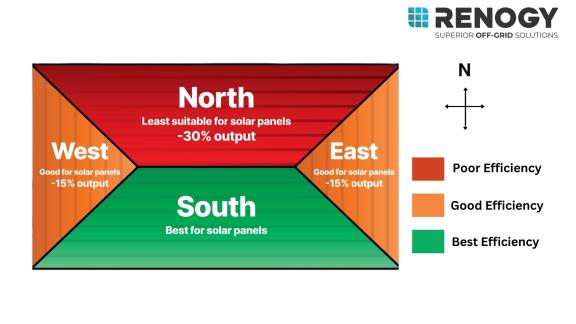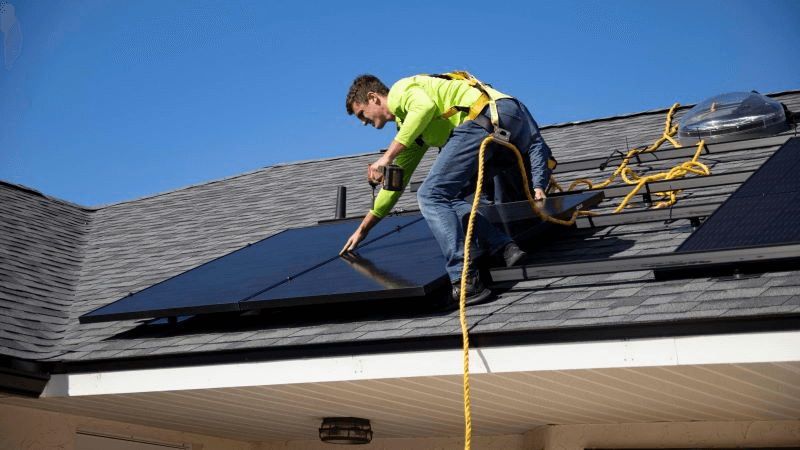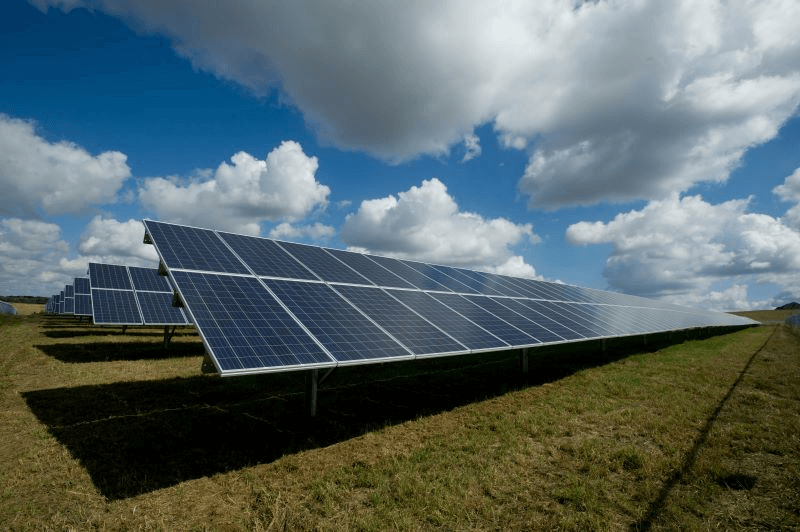What is the Best Direction for Solar Panels to Face
Determining the best direction for solar panels is crucial to utilizing the sun’s limitless energy maximally. The decision may seem simple to assign a cardinal direction for the panels to face. However, it is more complex and has a direct influence on the amount of electricity produced.
When deciding the solar panel orientation, you need to understand the sun’s movement around your location. It may appear to you that the sun moves generically throughout the day, but owing to Earth’s inherent tilt and orbit around the sun, the exposure time varies with location. This article will help you assess accurately which way solar panels should face optimal solar output.
Best Roof Direction For Solar Panels
Going by the larger say, the best roof direction for solar panels is roughly south-facing, and this is known because the sun is mostly seen in the southern sky or the northern hemisphere.
Importance of Roof Direction for Efficiency

Finding the best roof direction for solar panels will significantly influence the success of your solar system installation. Within every solar panel, there exist several photovoltaic (PV) cells that absorb sunlight. They’re built of a semiconductor material that absorbs specific wavelengths of light, called a bandgap. The bandgap is known to be very selective about the waves it usually absorbs.
Therefore, the PV cells need the sun's radiation to fall right on them to seize most of it. With even the slightest movement of the sun, these cells begin to reflect wavelengths instead of absorbing them. If you want to utilize most of the solar energy, you must orient your solar panels ideally and at appropriate angles, which can increase your solar efficiency considerably.
Effective Solar Panel Orientation & Tilt
It is noted that solar panels facing south and tilted between 15 and 40 degrees can improve energy output by up to 30% or more. However, factors such as roof slope and proximity to the equator may have you considering other directions. Therefore, you can also opt for east—or west-facing roofs, which are also believed to receive maximum sun exposure throughout the day.
In contrast, the north is believed to be the most inappropriate facing for solar panels as it receives inadequate sunlight during the day. With north-facing panels, you will need to align your solar panels much more steeply, around 60 degrees, to be able to adequately seize as much reflected light as possible. Still, the energy output will be much lower than that of southeast or west-facing roofs throughout the year.

Factors Affecting the Direction Of Solar Panels
If you are considering a solar installation, you must know what direction solar panels should face to yield maximum energy. When determining the best roof direction for solar panels, you must know certain factors that determine how your solar panels are oriented. Here are a few factors that affect the direction of solar panel installation:
- Geographical Positioning:Geographical positioning is a fundamental aspect that determines the orientation of solar panel installation. Earth orbits the sun on a tilted axis, suggesting that regions closer to the equator will have better sun exposure and lead to higher energy production.
- Roof Orientation and Angle:If south-facing roofs are not doable, solar panels that face east or west can also generate sufficient energy and save you money. To satisfy your electricity needs, install a few extra panels or look for ground-mounted solar or carport installations.
- Daily Time Frame: It is crucial to recognize that, unlike daylight hours, peak sun hours suggest a time frame when solar radiation reaches a power density of 1,000 watts per square meter. Now, this period lasts between 11 a.m. and 4 p.m. These are the hours when the sun is at its highest position in the sky, ensuring optimal solar radiation for your panels.
- Interferences and Shading Impacts: Do not let any objects overshadow the solar panels. Shading can drastically reduce the efficiency of the solar panels, reducing the return on investment from your solar installations.
- Climatic conditions:Although climatic conditions impact the efficiency of solar panels, solar panels can still lead to sufficient power generation even in bad climatic conditions. Therefore, it is essential to meticulously assess the orientation and angles of the solar panels.
- Temperature Changes: The duration and intensity of the sun’s radiation vary throughout the year, making it important to adjust the panel’s facing accordingly. While high temperatures are often thought to boost efficiency, they can also harm your solar panels. Similarly, snow can either lessen or intensify performance, depending on its impact on panel exposure.
Renogy's solar panels are ideal for those looking to go solar for a non-polluting and affordable lifestyle. Renogy’s high-quality solar technologies are built to survive through the ages so that your investment never goes obsolete.
How Much Does Solar Panel Direction Impact Output?
Understanding how much solar panel direction or orientation impacts the overall electricity output is crucial. According to the prevailing understanding, adequately oriented solar panels maximize yield by 30% compared to wrongly aligned solar panels.
The equator divides Earth between the northern and southern hemispheres and receives maximum sun exposure. Therefore, it's optimal for solar panels to be placed southwards in the northern hemisphere. The opposite is true if you reside in the southern hemisphere; then you should consider orienting the solar panels facing north so they are exposed to the sun throughout the year.
Also, facing panels west has considerable benefits, as their output will better match peak electricity demand in the evenings. West-facing solar panels have been found to reduce a home's reliance on the grid during peak hours more than south-facing solar panels.
Solar panels see a drop in solar power production when faced away from the true south. The size of the output drop will depend on where the solar panels are facing. Here are the solar panel directions and their probable impact on the energy production:
Southwest or Southeast orientation: Solar panels installed on a roof facing southwest or southeast are known to yield about 8% less power than the same panels in the same climate on a south-facing roof.
East and West orientation: Solar panels mounted on a roof that faces either east or west will produce roughly 15% less energy than panels facing south at a similar pitch.
North orientation: Panels mounted on a roof facing north produce energy roughly 30% less than panels facing south. Turning solar panels away from the true south will generally reduce output by less than 30%, but in some cases, losses of close to 60% may be seen. The precise drop is determined by how far north your location is, the number of degrees the panels are turned away from true south, and the pitch of your roof.

What If Your Roof Doesn't Face South?
Even if the solar panels do not face the southern direction, the solar installations can still produce large amounts of electricity. If your residence faces east or west in cardinal directions, you will only witness a 20% decrease in energy production.
Despite the decrease, solar panels will continue generating sufficient solar power and save you hundreds of dollars each year. Here are some considerations for those who don’t have south-facing roofs:
- Install Solar Panels on the Roof: If you don’t have a south-facing roof, consider compensating for the low level of sunlight by installing more solar panels. Solar panels account for only a small proportion of total costs, so you should be able to add a few extra panels without straining your budget.
- Install Ground-mounted Solar Panels: Installing ground-mounted solar power systems allows you to position the solar panels for optimal angle and direction, which maximizes your solar power output. Solar arrays on the ground are easier to maintain. You can brush off snow or leaves without doing much work.
- Employ Solar Panel Trackers: If it does not burn a hole in your wallet, consider employing solar panel tracking systems. They can enhance a system’s output by ensuring consistent and direct sun exposure throughout the day and across different seasons. Solar panel trackers help generate more electricity by occupying about the same space as other solar installations.
Renogy’s portable solar panels are ideal for those wanting to live more economically and generate their own power. The monocrystalline and bifacial solar panels of various wattages can increase solar efficiency by up to 30%. Further, you can claim a 30% residential clean energy credit when buying solar panels.
Conclusion
Proper orientation is the ideal place to start when contemplating the best direction for solar panels. Look into the nuances and factors involved in determining the proper orientation of your solar panels, as improper orientation will prevent solar panels from getting enough exposure to the sun, drastically reducing your electricity output. Solar panels are ideal for reducing your electricity bills and carbon footprint. Renogy’s solar panels and solar kits will help you reduce your electricity bills and switch to clean energy.
FAQs
1. Which is more important: direction or angle?
The direction of the solar panel is more important than the angle. The solar panel’s angle is rarely a limiting factor, and most roof tilts work fine. The wrong angle in a correct solar orientation might produce more energy than the correct one in a wrong orientation.
2. What direction should solar panels face?
The best direction for solar panels is considered to be south-facing. Solar panels are most efficient when they face south, which allows for optimal electricity production. East or west-facing panels can also work well but may produce 15–20% less energy than south-facing panels.
3. Do solar panels need to be south-facing?
Solar panels don't need to face south to generate energy, but it's usually the best direction for the most output. A south-facing solar panel can provide the highest amount of energy by up to 30%. However, east—or west-facing solar panels can also produce enough energy throughout the day.











